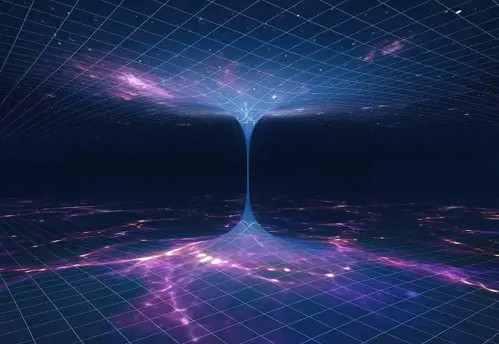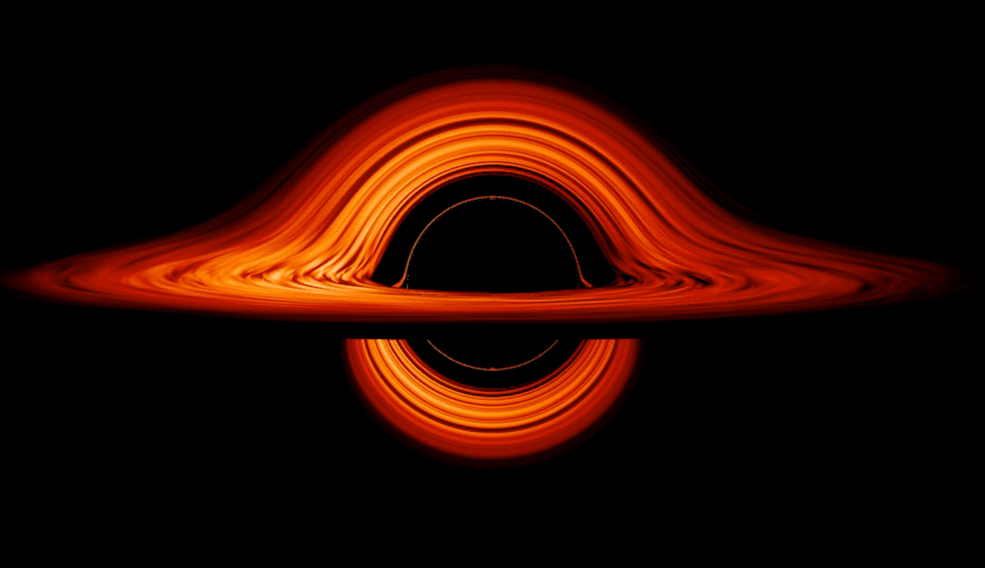Black holes are some of the most mysterious objects in the universe. They are so dense that not even light can escape their gravitational pull. But what if black holes are not what we think they are? A new study published in the journal Physical Review Letters suggests that some black holes may actually be tangles in the fabric of space-time.
The study, which was conducted by a team of physicists from the University of California, Berkeley, found that when two black holes merge, their gravity can create a strong wave that travels through space-time. This wave can cause the fabric of space-time to become tangled. If the tangle is strong enough, it can form a black hole.
The study's authors say that this new theory could explain some of the strange properties of black holes. For example, black holes are known to emit Hawking radiation. Hawking radiation is a form of radiation that is emitted by black holes. The radiation is caused by the interaction of the black hole's gravity with the fabric of space-time.
The study's authors say that the tangle theory could explain why Hawking radiation is emitted. They say that the tangles in the fabric of space-time can create a "leaky" black hole. This means that some of the energy from the black hole can escape through the tangles.
The study's findings are still preliminary, but they could have a major impact on our understanding of black holes. If the tangle theory is correct, it would mean that black holes are not as simple as we once thought. They would be much more complex objects, and their behavior would be much harder to predict.
The study, which was published in the journal Physical Review Letters in April 2023, was conducted by a team of physicists led by Sean Carroll, a professor of physics at the University of California, Berkeley. The team used a computer simulation to study what happens when two black holes merge.
The simulation showed that when the two black holes merge, their gravity creates a strong wave that travels through space-time. This wave can cause the fabric of space-time to become tangled. If the tangle is strong enough, it can form a black hole.

The study's authors say that this new theory could explain some of the strange properties of black holes. For example, black holes are known to emit Hawking radiation. Hawking radiation is a form of radiation that is emitted by black holes. The radiation is caused by the interaction of the black hole's gravity with the fabric of space-time.
The study's authors say that the tangle theory could explain why Hawking radiation is emitted. They say that the tangles in the fabric of space-time can create a "leaky" black hole. This means that some of the energy from the black hole can escape through the tangles.
The study's findings are still preliminary, but they could have a major impact on our understanding of black holes. If the tangle theory is correct, it would mean that black holes are not as simple as we once thought. They would be much more complex objects, and their behavior would be much harder to predict.
The study is just one of many recent studies that have challenged our understanding of black holes. In recent years, scientists have learned that black holes are not just simple objects that swallow everything that comes near them. They are actually very complex objects that can emit radiation, have a magnetic field, and even spin.
The more we learn about black holes, the more we realize that they are one of the most mysterious objects in the universe. We still have a lot to learn about them, but the new study by Carroll and his team is a step in the right direction.
Summary:
- Black holes are some of the most mysterious objects in the universe.
- A new study suggests that some black holes may actually be tangles in the fabric of space-time.
- The study was conducted by a team of physicists from the University of California, Berkeley.
- The study found that when two black holes merge, their gravity can create a strong wave that travels through space-time.
- This wave can cause the fabric of space-time to become tangled.
- If the tangle is strong enough, it can form a black hole.
- The study's findings are still preliminary, but they could have a major impact on our understanding of black holes.
- If the tangle theory is correct, it would mean that black holes are not as simple as we once thought.
- They would be much more complex objects, and their behavior would be much harder to predict.
Conclusion: the recent research suggesting that some black holes may be tangles in the fabric of space-time is a fascinating and exciting development. While more research is needed to confirm this hypothesis, it has the potential to revolutionize our understanding of black holes and the universe as a whole.
If this hypothesis is correct, it would mean that black holes are not the mysterious and impenetrable objects that we have long thought them to be. Instead, they would be simply kinks in the fabric of space-time, caused by the collapse of a massive star. This would make black holes much more accessible to study, and could lead to a better understanding of how they work.
Of course, there are also some challenges to this hypothesis. For example, it is not clear how a tangle in space-time could produce the same gravitational effects as a black hole. However, these challenges are not insurmountable, and the potential rewards of this research are great.
The research on black holes is still in its early stages, but it is already clear that these objects are some of the most mysterious and fascinating in the universe. The discovery that some black holes may be tangles in the fabric of space-time is a major step forward, and it could lead to a new understanding of these enigmatic objects.
Discover More
Most Viewed
Christmas is a season of joy, love, and traditions. And what better way to get into the holiday spirit than through timeless carols? These musical gems have been bringing people together for generations. Here’s our ranked list of the Top 10 Christmas Caro…
Read More
















